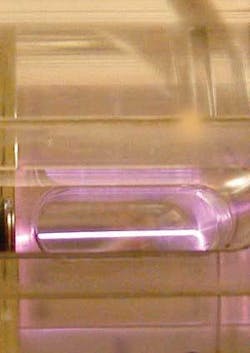LASER PHYSICS: Lasers accelerate electrons in short order
A breakthrough in using lasers to accelerate electrons, achieved by researchers at the Lawrence Berkeley National Laboratory (LBNL; Berkeley, CA) and Oxford University (Oxford, England), could be used to create free-electron lasers that in turn could produce femtosecond pulses of radiation tunable from x-ray to terahertz frequencies.1 The researchers combined LBNL work by Wim Leemans and others on plasma-guided laser-wakefield electron acceleration with plasma-channel-waveguide expertise from Simon Hooker and his group at Oxford, and reported accelerating electrons from 0 to 1 GeV in a distance of just 3.3 cm.
Laser wakefields
Plasma-an ionized gas-holds many free electrons. An intense laser pulse traveling through a plasma pulls some electrons in its wake, and transfers energy from the laser pulse to the electrons. Laser wakefields can produce electric fields as large as 100 GV/m, whereas conventional RF (radio-frequency) accelerators are limited to accelerating fields of 50 MV/m or less. Current linear accelerators might require the length of a football field to produce a 1 GeV beam.
In previous work, however, laser-wakefield accelerators were unable to transfer more than about 100 MeV because the acceleration could not be maintained over a long-enough distance. While a 100 MeV electron beam is useful for a number of industrial and medical applications, it is not in the same class as the large accelerators such as the 3-km-long 50 GeV Stanford Linear Accelerator (SLAC, Stanford, CA).
The acceleration is limited by the dephasing length. This is the point at which the electrons move ahead of the wave and begin to lose energy rather than gaining it. For an unguided laser beam, the dephasing length is about the same as the Rayleigh length.
Leeman’s group produced a high-quality 1 GeV electron beam from a 3.3-cm-long, 310-µm-diameter hydrogen-gas-filled capillary (see figure). The capillary was made from two machined pieces of sapphire. The group created the plasma using an electrical discharge through the gas. (In previous versions, the gas was ionized using laser pulses. However, as Leeman comments, “a 1 J capacitor is much cheaper than a 1 J laser.”) The plasma was most dense around the edges, leaving a low-density area down the center that acted as a waveguide for the laser light. “Each cross section of the channel acts like a positive lens, continually focusing the beam toward the center of the channel,” explains Hooker.
Pulses from a Ti:sapphire laser at 810 nm were focused into the end of the capillary. Operated at a 10 Hz repetition rate, the laser provided pulses as short as 40 fs full-width at half-maximum with up to 40 TW peak power, focused into the capillary entrance. The pulse creates an intense wake in the plasma, trapping bunches of free electrons and accelerating them to greater than 1 GeV.
Finding the sweet spot
To produce a beam of electrons with uniform energy, the researchers had to balance several mechanisms to find the “sweet spot” where high energies and good beam quality could both be achieved.
The researchers achieved high-quality, reproducible 0.5 GeV beams using smaller 225-µm-diameter capillaries, a smaller spot size, and lower laser energies, but had to switch to a larger-diameter capillary to achieve higher powers. Larger channels don’t guide the beam as well. They also require a larger input-spot size, but this can cause the electron beam to spread out-a definite drawback for free-electron lasers. The laser had to be focused in just the right spot; misalignments as small as 15 µm reduced power by as much as 20%. The laser pulse needed to arrive at the optimal time after the discharge for the plasma to work as a guiding channel. If a laser pulse arrived when the plasma was not in the desired configuration, the laser damaged the sapphire walls of the capillary.
When the laser operated at 38 TW peak power, the researchers saw no electron beam. At 40 TW, they achieved a good-quality beam, with electron energies that varied within each bunch by 2.5% at most. At higher powers, the electron-beam quality degraded, with significant shot-to-shot fluctuations. The researchers are now looking into injection schemes and multistage acceleration, both of which could provide more-stable electron beams with less finicky requirements.
The pulses of femtosecond electrons could be used as a free-electron laser, which in turn can produce radiation ranging from x-ray wavelengths to the mid-IR. While such lasers could be more compact than current schemes, the equipment required would still be the size of a building.
In the more-immediate future, the work may produce much shorter high-energy accelerators. Leeman believes that the group can create a 10 GeV accelerator shorter than 1 m in length. “Although,” he adds, “we’ll probably need 30 m worth of laser path.”
REFERENCE
1. W. P. Leemans et al., Nature Physics 2 (10), 696 (2006); doi:10.1038/nphys418.
Yvonne Carts-Powell | Freelance Writer
Yvonne Carts-Powell is a freelance writer living in Belmont, MA.
